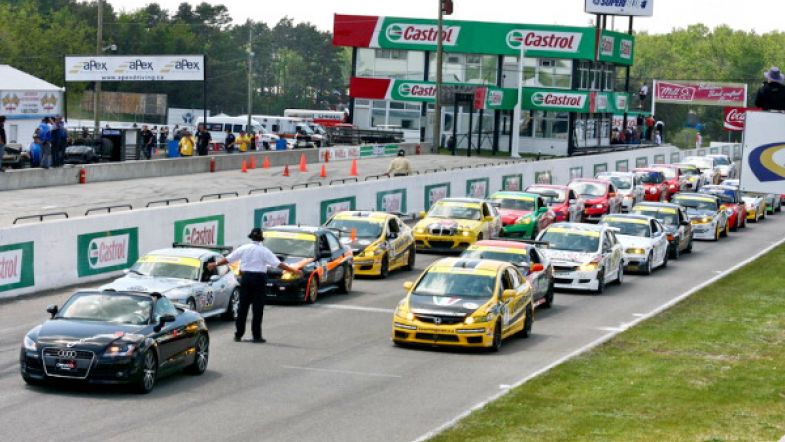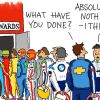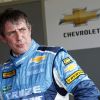Canadian championship shines in new season
In only it’s fourth year, the Castrol Canadian Touring Car Championship is a shining light for the touring car formula on the North American continent – with 39 cars taking part in the first race of the season, big names looking into the series and manufacturers adding support.
TouringCarTimes spoke to the series director of the Castrol Canadian Touring Car Championship, John Bondar after it’s first race of 2010.
TcT: The Castrol Canadian Touring Car Championship appears to be going from strength to strength this season – could you give us a quick overview of how the series works?
“Sure, basically it’s a Canadian version of the touring car championships that you see around the world. The closest thing for me to reference are the American series, so I draw some ideas from them to do the championship here…and obviously I keep an eye on what’s going on around the world, with touring cars or V8’s.”
“We are broken into two categories of cars, our entry level is the Touring class – and then our advanced level is Super class.”
“The entry level touring class is for more of what we call originally equipped or stock, closer to something that you take of the street with approximate horse power of about 200hp, typically they max out at about 2 litres engine size, though we do have a 2.5 litre six cylinder running but it’s a non-competitive product…of course the standard safety equipment. We do limit the tyre size, everyone runs on the same size – we also limit the octane level in the fuel, so they can’t go too crazy with the motors. We don’t have the staff…to keep taking apart engines every weekend, so we limit performance through the octane.”
“The Super class is up to three litre motors, a lot more freedom in what they can do with it – one of the differences in the categories is the brakes – in the 2 litre category we want to see the original equipment size on the brakes, but Super class they can go with the big brake packages, also a bigger tyre, and more aerodynamic allowances, that is just the front splitter and the rear wing – whereas the cars have to look like they came out of the show room.”
 Lombardi Racing’s ‘Super class’ Honda Civic Si’s
Lombardi Racing’s ‘Super class’ Honda Civic Si’s
TcT: The regulations in the production class seem pretty tight, isn’t there an inherent risk that some cars will be more competitive than others if the teams aren’t able to make improvements?
“Yes, but we do equalise them with weight…we’re aware of some of the performance differences so we will run them at different weights – that’s the same for the Super class also.”
“If you win a race, you get a present – you get 50lbs (23kg) of lead, to a maximum of 250lbs (113kg).”
TcT: I see the series has a manufacturer championship, but there’s limited actual manufacturer involvement in the series at the moment?
“Absolutely correct – currently we only have one manufacturer backed team, and that is Hyundai – next year we’ll have two with the return of Honda…they went on sabbatical for two years.”
“The team was very clearly told that they’re not stopping, they’re just taking a holiday – this will be year two that they’re gone, and I’ve already had them phoning me saying they have approvals for next year.”
“Honda here, they budgeted a downtime for the downturn in the economy – they said there’d be ten quarters of poor performance in the automotive market, and here they’ve already announced additional manufacturing starting in the fall, so they’re gearing up for it.”
 The Hyundai Genesis of G1 Racing
The Hyundai Genesis of G1 Racing
TcT: Whilst some series, particularly World Challenge in the US have been struggling with grid sizes, yours appears to be going the other way, you must be pretty pleased with that?
“I’ve been very fortunate. Last year, even though the world was ending, my participation went up about 15% – and last year I averaged 37 cars per race. Wherever we went, we were the largest show, even amongst the real high-level professional events.”
TcT: And even at the first round of this year, 39 cars entered at Mosport?
“Yes, and I expect us to average around 40 – there’s still another 15 cars to come, and through that, some drivers will miss a few races, a few weekends; I think we’ll average around 40.”
TcT: With a 40 car grid, but two distinct classes – is it not tempting to split the competition out into two separate races, or do you like having 40 cars on the grid?
“Actually yes, it’s a great show. This past weekend the grid split was about 50/50.”
“By the end of the race, the top car had just started to lap the slower category – so we’re good there, the track’s not too crowded – it just provides a better show. I prefer a crowded track.”
TcT: What about with the circuits, with 40 cars that must be a pretty crowded pitlane?
“No not really, because if anybody comes into the pits during the race they’re finished. We won’t have more than one or two cars coming in. It’s a bit busy during practice and qualifying, but everybody makes room for each other – largely they’re just making small adjustments to the suspension or tyre pressures – they may a change a tyre but largely they set the car up for practice or qualifying and then they go.”
TcT: The championship races solely at circuits in Ontario and Quebec, on the East coast of Canada. Are there any plans as the series grows to move out to the West?
“Oh, I’d very much like to grow to the West – there’s competitors out there that call me and ask me to try to facilitate that. The current plan – I can see in about another year is that I’ll start a western series, just to cater to the western group.”
“Our distances here are just too big to go back and forth, we just can’t afford it.”
“The market here in Canada, these two provinces make up the largest population in Canada, and there’s about 7-8 race tracks here, so it’s the best we have so we’re making use of it.”
 Dave Cieklewicz’s Subaru Impreza
Dave Cieklewicz’s Subaru Impreza
TcT: The race format of 30 minute, short sprint races has a very European flavour – unlike a lot of other US/Canadian championships which seem to favour longer races.
“I think we’re going to stick with the sprint format, we think it’s more dynamic, more entertaining. To clarify, the way it works – we have qualifying for our first race, and that is in effect a heat race that sets the grid for the second race. Both races are full points, and we just find they’re very intense and dynamic.”
“I’m a sincere race fan and I watch a lot, but I think you’ll agree that middle part of F1 is boring, the middle three hours of a NASCAR race are a complete write off – so I think the best way to capture an audience is to keep it intense and quick.”
John also told us about the new features that the Castrol Canadian Touring Car Championship will feature soon:
“We’ve captured the imagination of the racers – our audience is growing. One of the things we’re doing this year, we’ve got live timing available on the website, we’re also shooting ‘webisodes’. Our web episodes are shot each weekend and are put together for publication on the site.”
“We hope to have an episode of between 6-8 minutes that we will publish – and in it will be a lot of personalities, and lot of interactions with the teams, and in it will be a race re-cap.”
TcT: I also heard that there was a possibility the Jacques Villeneuve was going to race in the series as well?
“Well, last year I met with Jacques at ICAR – we had a great meeting. I invited him to do our podium presentation, and he did – which was wonderful, great thrill for all the drivers – and a few weeks later I had him testing one of our cars with the goal to put him in it. We couldn’t put a deal together, but just to have that happen is just a thrill. You never know how things will go, I might get him in a car yet.”
“In DTM in Germany, we’ve got Bruno Spengler – it’d be great to have him come back and run an event.”
John summarised his goals for the championship
“I’ve been in motorsports about 25 years, I started like many, I was waiving flags and putting out fires – then I drove a little bit, sedans – some formula cars – but most importantly I got involved in the administration side…I get involved with our national body, and through that I’ve built a network of allies cross the country and learned some of the idiosyncrasies of motorsports – so I’m using all that to push things forward.”
“I’m really working hard to get everybody out to the track, and to grow motorsports…I’m doing this because there’s an opportunity, there’s a need – and like all of us I’m passionate about it, and just want it to succeed.”
For more information on the Castrol Canadian Touring Car Championship, go to www.touringcar.ca










